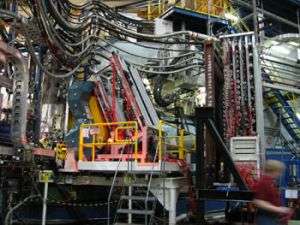Protons Pair Up With Neutrons

Research performed at the U.S. Department of Energy’s Thomas Jefferson National Accelerator Facility has found that protons are about 20 times more likely to pair up with neutrons than with other protons in the nucleus. The result will be published online by the journal Science, at the Science Express website.
The result, based on the first-ever simultaneous measurement of such pairings and their constituents, could have implications for understanding the structure of nuclear systems from light nuclei to neutron stars.
Protons and neutrons, or nucleons, in the nucleus of the atom can form a brief pairing with another nucleon, a phenomenon known as a short-range correlation. Previous experiments have shown that roughly one-fifth of nucleons at any one time were in short-range correlations.
Jefferson Lab Staff Scientist Douglas Higinbotham and his colleagues conducted an experiment in Jefferson Lab’s Experimental Hall A to directly and simultaneously measure the constituents of the short-range correlations in the carbon nucleus.
“These correlated nucleons have a high relative momentum. If you knock one out one way, the correlated nucleon will fly out in the opposite direction,” noted Higinbotham. “We set up our detectors to take advantage of this.”
The experiment found that 18 percent of all protons in the nucleus were paired with neutrons. Another one percent of protons were paired with protons, with about the same percentage of neutron/neutron pairs.
“I think it shows, for the first time in a very clear and unambiguous way, this fact that the large momentum nucleons in nuclei are coming in pairs. And they’re coming mainly in proton/neutron pairs,” said Eli Piasetzky, a professor at Tel Aviv University and a spokesperson on the experiment.
Higinbotham agreed. “The result from this experiment is like finding that missing piece needed to finish a puzzle. This experiment, combined with others, gives us a very coherent picture of these short-range correlations in the nucleus.”
In the experiment, a beam of energetic electrons was sent into a thin sheet (0.25 mm) of Carbon-12. The scientists were interested in the electrons that interacted with a member of a short-range correlation. Recoil electrons and knockout protons were measured in Jefferson Lab Experimental Hall A’s High Resolution Spectrometers. Correlated protons and neutrons were measured in the BigBite large acceptance spectrometer and a neutron detector. The ability to clearly resolve the short-range correlated pairs is due to the high energy and large intensity beam at Jefferson Lab.
When combined with a theoretical calculation of the effects of proton/neutron correlations on the momentum distribution of the nucleons in neutron stars, the result also indicates that the presence of short-range correlations may have a disproportionately large effect on neutron star structure.
Source: Thomas Jefferson National Accelerator Facility





















